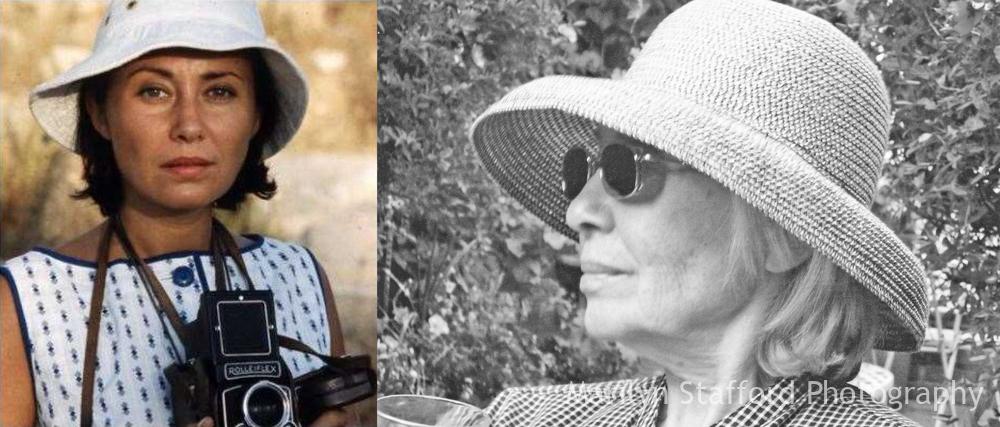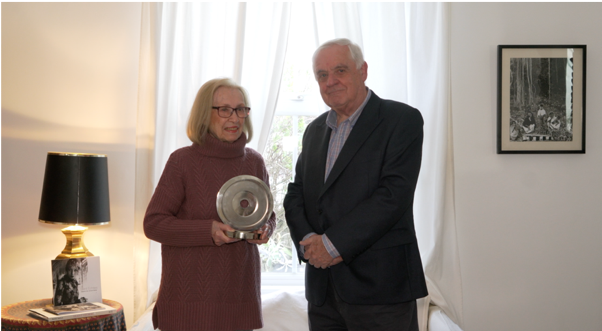Biography
“Photographers don’t grow old – they just grow out of focus”

Born in Cleveland, Ohio, USA, in 1925, Marilyn Stafford (née Gerson) planned to become an actress and singer following her training at the Cleveland Play House. In 1946 she moved to New York City, where she was given small acting roles off broadway and in early television.
Stafford was given a rolleiflex camera by a friend in New York in 1947, which first piqued her interest in photography and to support herself in between acting roles, she found work assisting US fashion photographer Francesco Scavullo.
Her photographic career was formally launched in autumn 1948 when she took her first portrait of Albert Einstein for friends who were making a documentary film about him. She was given a 35mm SLR camera for the first time and a quick lesson in how to use it in the back of the car on the way to his house in New Jersey.


At the end of 1948 Stafford joined a friend on a visit to Paris and her career took on a new dimension. For a short while she sang with an ensemble at Chez Carrère, a dinner club off the Champs-Élysées, where she became friends with the war photographer and Magnum co-founder, Robert Capa, and she met French singer, Edith Piaf, through her fellow American band member, singer/songwriter Eddie Constantine.
On a ferry crossing to England in 1949, Stafford had a chance encounter with Indian writer, Mulk Raj Anand. She had been tasked by an American friend to buy some books in London and by an incredible twist of fate the writer of those books was sat beside her on the ferry. Anand became Stafford’s life-long friend and introduced her to Henri Cartier-Bresson, who was to become her photography mentor back in Paris. Stafford developed a particularly interest in street photography – in 1950 she would explore Paris by taking a bus to the end of the line. She happened upon the working-class neighbourhoods of Cité Lesage-Bullourde near Place de la Bastille, where she photographed children living in an area of slum housing and Boulogne-Billancourt, where she photographed street scenes and the homeless.


In 1951 Stafford spent a short period assisting US fashion photographer, Gene Fenn, in his Paris studio near Place de la Concorde and then worked for a public relations agency as a fashion photographer herself, an avenue of photography which was more welcoming to women. Fashion photography of haute couture clothing at that time was normally modelled in opulent surroundings but Stafford typically took a documentary approach, preferring to photograph the models on her beloved streets of Paris.
In 1956 she married Robin Stafford, a British foreign correspondent working in Paris. In 1958, whilst six months pregnant, Stafford went on a personal mission to Tunisia to document and publicise the plight of Algerian refugees fleeing France’s ‘scorched earth’ aerial bombardment in the Algerian War of Independence. Back in Paris she showed the pictures to Cartier-Bresson, who sent a selection to The Observer, which published two on its front page. In the same year as her first front page, Stafford’s daughter, Lina, was born.


In 1959 Stafford’s husband’s work took the couple and their young daughter to Rome, where she photographed Italian writers Carlo Levi , Italo Calvino and Alberto Moravio.
In 1960 her husband’s work moved the family on again, this time to Beirut for a year. Stafford travelled extensively in Lebanon during this time, photographing people and places, later published in her book Silent Stories: A Photographic Journey through Lebanon in the Sixties (Saqi, London, 1998).
Stafford and her husband returned to New York for a few years after Beirut while their daughter was very young, until they finally separated.
In the mid-1960s she moved to London as a single mother and found regular work with The Observer and other UK and international publications, particularly Vogue, Women’s Wear Daily and The Herald Tribune on both commissions and self-assigned projects and it was during this period that she photographed many celebrities of the day including Sir Richard Attenborough, Donovan, Sir Alan Bates, Twiggy, Ossie Clark, Margot Fonteyn, Rudolf Nureyev and Cecil Beaton among others. Stafford also photographed on the set of feature films and commercials for Women’s Wear Daily, including Sir Richard Attenborough’s directorial debut Oh What a Lovely War (1969).
Stafford was one of few women photographers working for national and international newspapers and magazines at the time and was also one of very few women on the camera / stills Executive Committee of ACTT / BECTU. This gave her an insight into the difficulty of balancing a career in photography with single motherhood, which many years later in 2017 led her to work with arts social enterprise, FotoDocument to launch the Marilyn Stafford FotoReportage Award to support women photographers globally.
In 1971-72, Stafford photographed Indira Gandhi, India’s only woman Prime Minister at home in Delhi and on her duties in Kashmir visiting military bases and wounded soldiers in hospital following the Indo-Pakistani War, which had led to the creation of the new state of Bangladesh.
Following this trip, Stafford went to Bangladesh in 1972 in the aftermath of the Bangladesh Liberation War to photograph its victims and the destroyed towns and villages, and to meet the founding father of the nation state of Bangladesh, Sheikh Mujibur Rahman.

During many further visits to India throughout the 70s until 1980, she contributed to the MARG Publication on Hampi – A UNESCO World Heritage Site and photographed the Adivasi Ghotul Muria and Warli Tribes.
A selection of Stafford’s work is included in the archives of the University of Texas, USA and she has been published and broadcast widely including: The Observer; The Guardian; The Times; ITV News at Ten; BBC Hard Talk with Stephen Sackur; BBC South-east, BBC North, The Los Angeles Times; Sussex Life.
In 2014, she met documentary photographer / FotoDocument founder, Nina Emett, who she worked closely with from then onwards to bring her work to the public eye, alongside members of the Marilyn Stafford Collective.
In 2017, the Marilyn Stafford FotoReportage Award for women photographers was launched in her honour by FotoDocument and is supported by Nikon UK.
In 2018, Stafford received an Arts Council England grant for a touring exhibition of her portrait and fashion work of the 50s, 60s and 70s in the south-east of England.
In February 2019, Stafford received an Award for Exceptional Achievement in Photography from best-selling UK publication, Amateur Photographer.
In March 2020, she received the Chairman’s Lifetime Achievement Award from the UK Picture Editors’ Guild Awards in London.
In October 2021, a retrospective book of her life’s work “Marilyn Stafford – A Life in Photography”, compiled and edited by Nina Emett, in collaboration with Stafford’s daughter Lina Clerke, was published by Bluecoat Press.
In 2021 and 2022, a retrospective exhibition of “Marilyn Stafford – A Life in Photography’’, curated by Nina Emett with support from Stafford’s daughter Lina Clerke, toured to Farleys House & Gallery, Brighton Museum & Art Gallery and Dimbola Museum & Galleries in the UK.
Marilyn passed away peacefully at her home on 2nd January 2023 at the age of 97, surrounded by loved ones.

